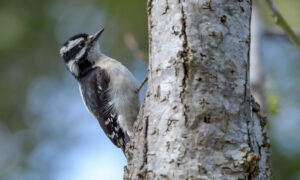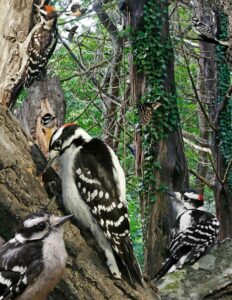An Introduction to the Downey Woodpecker
Ever noticed a tiny gymnast flitting around your birdfeeder if you reside in the U.S. or a large part of Canada? It’s likely you’ve had a Downey Woodpecker drop in. Now, whether you’re new to birdwatching or just intrigued by our backyard buddies, we’re here to feed your curiosity about these petite acrobats of the woodpecker clan.
Recognizing the Downey Woodpecker
Appearance
The Downey Woodpecker sports an appealing pattern of black and white feathers, almost as if it’s dressed in a checkered suit. Spotting the males is easy – look for a dainty red patch on the back of their heads. This compact bird, with its small size, can achieve feats that its larger relatives wouldn’t dare!
LifeSpan
Considering their habitat and petite size, these birds live an average span of 10-11 years. Strangely enough, the eldest recorded Downey touched the ripe age of almost 12!
Dwelling Places of the Downey Woodpecker
Rarely venturing far, Downey Woodpeckers nestle mostly in North America’s open woodlands. In these spaces, they prefer deciduous trees and shrubs, even your backyards! City parks are also a favourite, so are empty lots and occasionally, the walls of buildings.
Foraging Stunt of the Downey Woodpecker
Savouring insects inside the stems of weeds or navigating branches that would deter bigger fellows, the Downey Woodpecker’s small size certainly aids its agility.
The males show a peculiar behaviour during the harsh winter months. They dominate the premium foraging spots, predominantly leaving the abundant branches and tree trunks to the ladies. This strange gender-based partitioning of feeding turf is most pronounced when food availability plummets.
Interestingly, to efficiently scout for food, these clever birds often fuse into heterogenous flocks. This alliance allows them more time to forage while the group keeps a collective eye out for predators.
Behavioural Quirks of the Downey Woodpeckers
You might believe the drumming noise from woodpeckers is food hunting in action. The truth, however, is intriguingly different. Downey Woodpeckers are experts at silently sourcing food from bark. That drumming, you wonder? It’s all part of the courtship game! This racket is a necessity as the Downey Woodpecker lacks a song to woo its mate.
Unlike many of their feathered friends, the Downey Woodpecker does not migrate during winter. They are highly skilled at uncovering food hidden deep within the veins of rotting trees or branches, even in the cold months.
Additional Resources:





